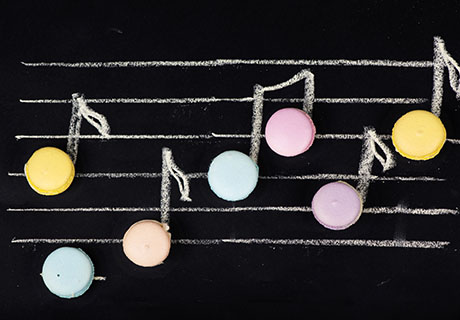

Some Prefer Footnotes: A conversation with Margaret Mitsutani about her translation of Yoko Tawada’s The Emissary
2021.09.10
- Margaret Mitsutani
- Yoko Tawada
Yoko Tawada’s Kentōshi, published by New Directions as The Emissary and by Granta as The Last Children of Tokyo, was first published in Japanese in 2014. Margaret Mitsutani’s English translation was published in 2018 and won that year’s National Book Award for Translated Literature. Mitsutani has previously translated several works by Tawada, including The Bridegroom was a Dog and Facing the Bridge. In this interview, Mitsutani discusses the wordplay at the heart of The Emissary and how there’s never “one right answer” in translation.
David Boyd and David Karashima: Your translation is published under two different titles: The Emissary in the United States, and The Last Children of Tokyo in the United Kingdom. Could you tell us a little about the book’s two titles?
Margaret Mitsutani: There are two titles because the British publisher wasn’t comfortable with “The Emissary.” The original title is Kentōshi, which, as a common noun, refers to the emissaries Japan sent to China beginning in the seventh century, although Tawada writes it with Chinese characters that mean something closer to “The Light Bearers.” I actually suggested “The Light Bearers” to the British publisher as an alternative title, but they finally decided on “The Last Children of Tokyo.” Tawada said that, while it wasn’t a title she would choose for herself, because a work no longer belongs to her alone after it is published, she would agree to this title, even though it unfortunately brings to mind things like “The Last Samurai,” or “The Last Rose of Summer.” In other words, titles with “last” in them tend to suggest a nostalgia, or sentimentality that is quite foreign to the mood of The Emissary.
DB & DK: Wordplay is central to this book. How do you view wordplay in Tawada’s work in general? As Tawada’s translator, how do you know when you’ve “got it right”?
MM: I’m not sure I would use the phrase “get it right,” because it suggests there’s one “right” answer, which there never is. A work inevitably changes in translation, and wordplay is the most extreme example of that, because you can’t simply translate the meaning of the original. One example where I managed to keep something of the original meaning is in a passage about a movement to find “Tokyo specialties” to make the city seem more attractive. Two suggestions are myoga and nettles; a man who comes to be known as Dr. Myoga because he’s promoting myoga, however, is quickly forgotten. Tawada writes that he has been covered up by bōkyakugusa (忘却草), the name of a plant she has made up, which would translate literally to something like “grass of forgetting.” This is obviously a play on wasurenagusa (勿忘草, or forget-me-not in English). I wanted a similar made-up plant name for the translation, so I used “forget-me-knotweeds,” which contains the sound of “forget-me-not” combined with “weeds,” which tend to grow wild and cover things up. “Knotweed” is actually the English name for a plant in the same family as tade (蓼, or smartweed in English), which was famously translated as “nettles” in the title of Tanizaki’s novel Some Prefer Nettles. Another example, where the meaning changes completely, is in the scene at the dentist, after Mumei’s baby teeth have all fallen out at once. The verb Yoshiro uses for “fall out” (欠ける) sounds like the verb for “write” (書ける), because Yoshiro was a novelist. In the translation, I have Yoshiro mumbling “Fall out” and hoping it didn’t sound like “fallout” (as in nuclear fallout), which has nothing to do with his profession, but a lot to do with the contamination that pervades the environment in the novel.
DB & DK: As one excellent example of how you’ve handled wordplay in this book, can we ask you to walk us through “lope” and “elope” (kakeochi)?
MM: The idea of words that have fallen out of use, or that must not be used, is an important theme in the novel. In this case, “jogging,” a word no longer used because it is foreign, has been replaced with kakeochi, the Japanese word for “elope.” Because Japanese readers know what it means, there’s no need for extra explanation. Fortunately, the English word “elope” contains the word “lope,” which means to run slowly, and could therefore conceivably be a replacement for “jogging.” But extra explanation is needed, so I added the bit about adding an “e” in front of it conjuring up visions of a young woman climbing down a ladder to run away with her lover, which I think is a standard image of elopement for Western readers.
DB & DK: Very early on in the book, there’s a wordplay-related footnote, the only one in the book–about “made”. How did this note come to be? How do you feel about footnotes in translation? When are they warranted or necessary?
MM: Since the younger generation in the novel no longer studies English, they read the word “made” on the “Made in Japan” labels as a Japanese word meaning “until” or “to,” written phonetically as “ma” (ま) de (で). I didn’t feel there was any way to convey that in the translation, so I explained it in a footnote. Actually, there is one more footnote, in the scene where Yoshiro’s grandson Tomo says he likes “Buying. Throwing. Drinking.” Japanese readers would know that these three verbs in this context would refer to “whoring, gambling and boozing” but again there was no way to convey that in the translation. I submitted the manuscript to New Directions with both of these footnotes, and my editor never said a word to me about either one, so they must not have bothered her. Although generally English language publishers tend to shy away from footnotes in works for “the general reader” (whoever that may be), I don’t see anything wrong with a footnote here and there. Footnotes can be irritating, as in the Penguin edition of Gulliver’s Travels, for example, which has a longwinded footnote explaining that Gulliver wouldn’t have been able to hear the Lilliputians because, given their physical proportions, their vocal cords would not have been able to produce sound audible to the human ear. (Kurt Vonnegut makes fun of the footnotes to the Penguin Gulliver’s Travels in one of his essays.) But I don’t think readers should object to a concise, helpful footnote.
DB & DK: Names mean a lot in this book—including Mumei’s, of course. How did you deal with characters’ names?
MM: Because Chinese characters have meaning, I think there’s a temptation to want to “translate” that meaning into English, as Pierre Loti did with Madame Chrysanthemum, or John Luther Long with Madame Butterfly in the nineteenth century. A more recent example would be John Lennon referring to Yoko Ono as “Ocean Child” in the song “Julia,” which I find rather charming, but when overdone, this sort of name translation can descend into a sort of cheap exoticism. For that reason, I left Mumei’s name as is; fortunately, at one point Yoshiro tells Tomo what it means, which lets English readers eventually find out what Japanese readers know as soon as they see the characters 無名。Yoshiro’s daughter’s name Amana contains the character for “south,” which seems suggestive since she ends up in Okinawa, but I simply wrote it phonetically. In another of Tawada’s novels, called 飛魂 all the characters’ names are written with unusual combinations of characters, and no indication as to how they should be pronounced, which is perhaps confusing even to Japanese readers. If I were to translate that novel, I’m really not sure what I would do with the names.
DB & DK: This book has received significant attention in your translation, including winning the National Book Award in the U.S. in 2018. Why do you think this work has struck such a chord with English-speaking readers?
MM: The Emissary received the National Book Award for the category Translated Literature in 2018. This category had been discontinued in the 1980s, so this book was the first winner since then. Although I don’t know anything about why the category was discontinued during the 1980s, or why it was resurrected in 2018, it is certainly tempting to see the decision to reinstate it as a sort of rebuke of Trump era xenophobia. In that sense, it seems particularly significant that the award was given to a novel by an Asian woman.
While I don’t think Tawada will ever be a best-selling author on the scale of Murakami Haruki, she seems to be developing an English fan base among readers who are interested in language itself. These readers seem to be attracted to her style in general, including things like wit and use of metaphor. Many reviews of The Emissary focused on the issue of language in the novel—the fact that the shelf-life of words is getting shorter, and that Yoshiro, who was a novelist, seems like a repository of lost words, some of which have been virtually abolished because they are foreign. In addition, because the Japanese original was published in 2014, the “isolation policy” Japan has taken in it seems somewhat prescient, with populist/nationalist governments appearing in numerous countries such as Hungary, Poland, Turkey, Brazil, and, with Trump’s election in 2016, the USA. America now has a new president, but many of these countries still seem to be closing in on themselves, as Japan does in The Emissary. And not surprisingly, quite a few readers connected the novel directly to the Fukushima nuclear disaster of 2011, which I believe is the event that led Tawada to write this novel in the first place. The contamination of the environment, due not only to nuclear meltdown, but also to climate change, is something else that definitely struck a chord with foreign readers. Yet at the same time, The Emissary is not a totally bleak dystopian novel like George Orwell’s 1984. The bond of love between Yoshiro and Mumei lends a faint ray of hope, and the humor that pervades the novel keeps it from getting too gloomy. The reviewer for the Guardian calls it “a dystopian novel like no other.”
Margaret Mitsutani was born in Pittsburgh, Pennsylvania, and has lived in Japan since the late 1970s. She holds an MA in comparative literature from Tokyo University and is now a professor emeritus at Kyoritsu Women’s University. She has translated works by Tawada Yoko, Kakuta Mitsuyo, Oe Kenzaburo, and others. In 2018, her English translation of Tawada Yoko’s The Emissary received the National Book Award for Translated Literature.
David Boyd is Assistant Professor of Japanese at the University of North Carolina at Charlotte. He has translated fiction by Hiroko Oyamada and Mieko Kawakami, among others. His translation of Hideo Furukawa’s Slow Boat won the 2017/2018 Japan-U.S. Friendship Commission (JUSFC) Prize for the Translation of Japanese Literature.
David Karashima is Associate Professor of Creative Writing at the School of International Liberal Studies, Waseda University. He has translated the works of a range of contemporary Japanese writers including Hitomi Kanehara, Shinji Ishii and Hisaki Matsuura. His nonfiction book Who We’re Reading When We’re Reading Murakami was published by Soft Skull Press in 2020.
Related
-

The Invisible Onlooker: A conversation with Lucy North, translator of Natsuko Imamura’s The Woman in the Purple Skirt
2022.03.16
- Lucy North
- Natsuko Imamura
-

Wrestling with Humourous Beasts: A conversation with Polly Barton, translator of Aoko Matsuda’s Where the Wild Ladies Are
2022.01.21
- Aoko Matsuda
- Polly Barton
-

Mimicking Mood and Manner: A conversation with Michael Emmerich, translator of Fukunaga Shin’s “Almost Everything in the World”
2022.01.18
- Michael Emmerich
- Shin Fukunaga
-

Living in a Storied Neighborhood: A conversation with Ted Goossen about his translation of Hiromi Kawakami’s People from My Neighborhood
2021.09.10
- Hiromi Kawakami
- Ted Goossen
-

Merely a Beautiful Dream? A conversation with Hitomi Yoshio, translator of Mieko Kawakami’s “Dreams of Love, Etc.”
2021.09.03
- Hitomi Yoshio
- Mieko Kawakami
